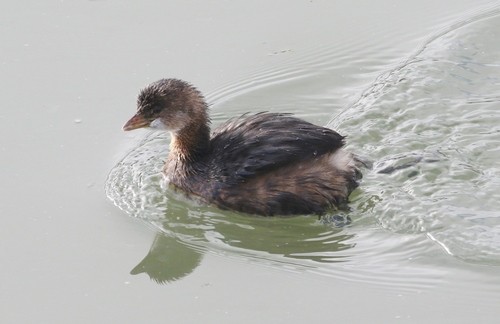Pied-billed Grebe
A species of Pied-billed and Atitlán Grebes Scientific name : Podilymbus podiceps Genus : Pied-billed and Atitlán Grebes
Pied-billed Grebe, A species of Pied-billed and Atitlán Grebes
Botanical name: Podilymbus podiceps
Genus: Pied-billed and Atitlán Grebes
Content
Description People often ask General Info
 Photo By silversea_starsong , used under CC-BY-NC-4.0 /Cropped and compressed from original
Photo By silversea_starsong , used under CC-BY-NC-4.0 /Cropped and compressed from original Description
Pied-billed grebes are small, stocky, and short-necked. They are 31–38 cm (12–15 in) in length, with a wingspan of 45–62 cm (18–24 in) and weigh 253–568 g (8.9–20.0 oz). They are mainly brown, with a darker crown and back. Their brown color serves as camouflage in the marshes they live in. They do not have white visible under their wings when flying, like other grebes. Their undertail is white and they have a short, blunt chicken-like bill that is a light grey color, which in summer is encircled by a broad black band (hence the name). In the summer, its throat is black. There is no sexual dimorphism. Juveniles have black and white stripes and look more like winter adults. This grebe does not have webbed feet. Its toes have lobes that come out of the side of each toe. These lobes allow for easy paddling. When flying, the feet appear behind the body due to the feet's placement in the far back of the body. It may be confused with the least grebe, although that species is much smaller and has a thinner bill. Other similarly sized grebes are very distinct in plumage, i.e. the eared grebe and horned grebe. Both species bear much more colorful breeding plumage, with rufous sides, golden crests along the side of the head against contrasting slaty color (also a rufous neck in the horned); while in winter, both the eared and horned grebes are pied with slaty and cream color and have red eyes. 
Size
30-38 cm (12-15 in)
Colors
Brown
Black
Gray
White
Life Expectancy
5 years
Nest Placement
Floating
Clutch Size
2 - 10 eggs
Incubation Period
1 - 2 broods
Number of Broods
23 - 27 days
Feeding Habits
Pied-billed Grebe primarily consume crustaceans, fish, and aquatic invertebrates. They dive to forage and use their bills and jaws to crush prey such as crayfish, crabs, and beetles. Opportunistic in diet, they also eat snails, mussels, dragonfly nymphs, various insects, leeches, frogs, and tadpoles, adjusting to availability. Pied-billed Grebe may consume plants and ingest feathers for digestion.
Habitat
Pied-billed Grebe's habitat encompasses freshwater wetlands with open water and dense vegetation, and sometimes slightly brackish areas. Common from sea level up to 8,000 feet, they inhabit marshes, lakes, and slow rivers, extending to man-made bodies like sewage ponds. Their habitable range covers broad regions of the Americas, and they adapt well to both urban and rural environments.
Nest Behavior
Both pied-billed Grebe sexes partake in nest construction, typically starting 3-5 days before egg-laying. They can rapidly create a supportive platform, sometimes in a single day. Nest-building continues as eggs are laid, which expands the nest to fit more eggs. After laying, pied-billed Grebe exhibit diligent parental care.
Nest Characteristics
Pied-billed Grebe construct their nests on floating vegetation platforms in water bodies, often among tall plants but also in shallower vegetation. The nests are built with materials like bulrushes, water lilies, and small sticks, creating an open bowl shape that is about 4-5 inches in diameter and 1 inch deep, with unique floating capabilities.
Dite type
Aquatic invertebrate eater
People often ask
General Info
Feeding Habits
Bird food type
Sounds
Call
Recording location: United States
Call
Recording location: United States
Behavior
Pied-billed Grebe are well-adapted waterbirds, spending most of their time in aquatic environments. They primarily engage in diving to forage, often plunging beneath the water amongst aquatic vegetation to feed on small prey. Uniquely, pied-billed Grebe exhibit a 'crash-diving' technique to escape threats, which is characterized by a distinctive head and tail posture just before submerging. They can also dive quickly or sink subtly, disappearing without a trace. This species demonstrates a protective parental behavior, carrying chicks under their wings while diving, although mishaps where a chick may get dislodged can occur. When danger lurks, pied-billed Grebe can stealthily submerge with only their eyes and nostrils exposed, resembling a crocodile. Aggressive territorial and mating behaviors are observed during the breeding season, including chasing and underwater attacks, as well as elaborate courtship displays involving synchronous head-jerking and underwater sprints that disturb the water's surface. Taking flight from water is laborious for pied-billed Grebe and necessitates a lengthy runway of paddling and flapping to become airborne.
Distribution Area
They are most commonly found throughout North America, Central America, the Caribbean, and South America year round. During the summer breeding season, they are most prevalent in central, northern and northeastern Canada. If they live in an area where the water freezes in the winter they will migrate. Migrating birds generally meet with year-round birds in September and October. They migrate at night. Most migratory birds leave in March or April. They make occasional appearances in Europe and Hawaii. In the United Kingdom, pied-billed grebe visits have numbered 37 sightings as of 2007, appearing generally in October to January. One bird in England bred with a little grebe, producing hybrid young. It is the only grebe on record to have visited the Galapagos Islands. Pied-billed grebes are found in freshwater wetlands with emergent vegetation, such as cattails. They are occasionally found in salt water. When breeding they are found in emergent vegetation near open water, and in the winter they are primarily found in open water due to the lack of nests to maintain. They may live near rivers, but prefer still water. They may be found in higher elevations when migrating. They will breed in restored and man-made wetlands. Pied-billed grebes live approximately 10–12 years. 
Species Status
Not globally threatened.